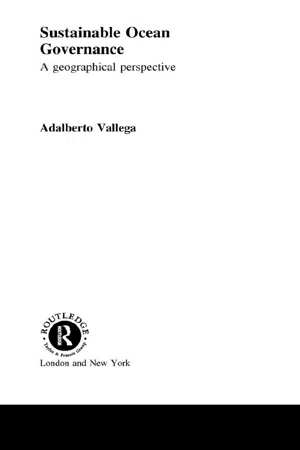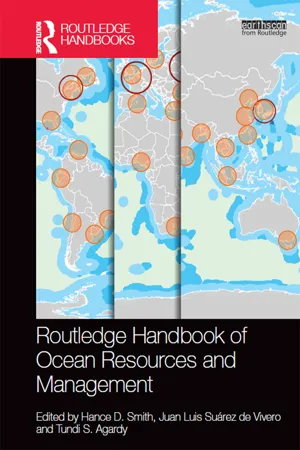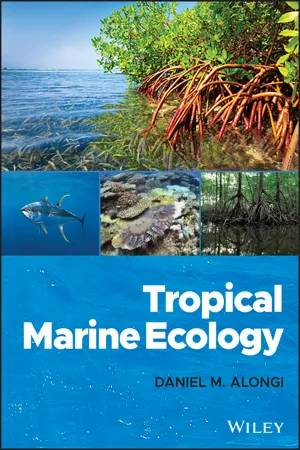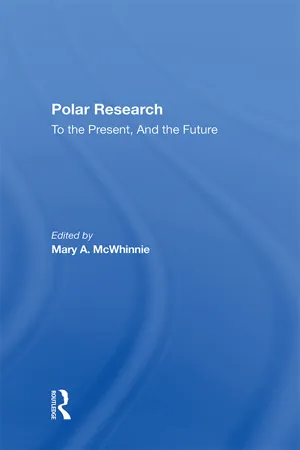Geography
The Biological Productivity Of the Ocean
The biological productivity of the ocean refers to the ability of marine organisms to produce organic compounds through photosynthesis and chemosynthesis. This process supports the growth of phytoplankton, which forms the base of the marine food web and sustains the entire ocean ecosystem. Factors such as nutrient availability, sunlight, and temperature influence the productivity of the ocean.
Written by Perlego with AI-assistance
Related key terms
Related key terms
1 of 4
Related key terms
1 of 3
7 Key excerpts on "The Biological Productivity Of the Ocean"
- eBook - ePub
Sustainable Ocean Governance
A Geographical Perspective
- Adalberto Vallega(Author)
- 2002(Publication Date)
- Routledge(Publisher)
Table 3.2 shows a framework of net primary productivity relevant to coastal and deep-ocean waters. Secondary productivity relates to the ratio between the primary organisational level of the trophic web and other levels. It refers to the levels above the primary level and gives some indication of the complexity of food chains.Productivity may be altered to some degree by human inputs. Two examples are significant. Firstly, solid waste discharged at sea may lead to increased turbidity of coastal waters. As a consequence, the penetration of solar radiation through the water column is reduced, photosynthesis is weakened and, as a final result, productivity decreases. Secondly, discharged water from the cooling systems of coastal manufacturing plants leads to eutrophication and increased primary productivity with knock-on effects on the rest of the food chain. These examples demonstrate that, as a principle, any human inputs altering productivity are best prevented or mitigated.Table 3.2 Ocean trophic webs: primary productivity3.4.2 Biodiversity
This property was adopted by UNCED as one of its key principles and was the primary concern of the Convention on Biological Diversity (1992). According to the scale of consideration, three kinds of biological diversity may be identified (Art 2): (a) genetic diversity, referring to the number of genes encapsulated in a species; (b) species diversity, referring to the number of species forming a community, and (c) ecosystem diversity - eBook - ePub
- Dr Andy Cundy, Andy Cundy, Steve Kershaw(Authors)
- 2013(Publication Date)
- Routledge(Publisher)
Falling dead plankton rain escaping the decomposer organisms in the water column and seabed communities are effectively lost from ocean ecosystems and become buried. That they do so has two benefits. Firstly, because photosynthesis converts CO 2 and H 2 O into carbohydrate and free O 2, every molecule of oxygen free in the ocean-atmosphere-land systems is represented (approximately) by one atom of carbon buried in sediment; if this did not occur, then free O 2 would be converted back to CO 2, and aerobic organisms would not exist. Secondly, carbon burial leads to petroleum generation, which drives human economy! Ocean productivity is closely tied to physical oceanographic factors. In particular: (a) Ekman transport generates coastal upwelling on west-facing coasts; (b) equatorial currents cause upwelling in the oceanic tropics; and (c) polar upwelling occurs because of temperature and salinity differences of water masses, especially the polar convergence zone between sinking cold Antarctic water and rising water in the South Atlantic. In each case, productivity is hugely increased because of updraught of nutrient-rich waters. Phosphorus, nitrogen, iron and silicon are commonly regarded as key nutrients, and phosphorus is the most important because it is in critical short supply. The current configuration of marine ecosystems is the end-result of millions of years of both biological and geological evolution, and shows that the true significance of marine ecology goes a long way beyond common perceptions of its meaning. - Hance D. Smith, Juan Luis Suárez de Vivero, Tundi S. Agardy(Authors)
- 2015(Publication Date)
- Routledge(Publisher)
Understanding marine environments
Passage contains an image
6 Blue Planet The role of the oceans in nutrient cycling, maintaining the atmospheric system, and modulating climate change
Susan M. LibesDOI: 10.4324/9780203115398-7Introduction
This chapter explores the role of the oceans in nutrient cycling, maintaining the atmospheric system, and modulating climate change. The essential connections between these topics are: (1) nutrients are one of the most important controls on biological productivity in the oceans, (2) this biological activity generates and consumes gases that are exchanged across the air–sea interface and (3) these gases play an important role in the natural greenhouse effect that moderates global climate. Rising levels of these greenhouse gases (GHGs) have the potential to cause the temperature of the atmosphere to rise.Readers are expected to understand basic concepts of biogeochemical cycling including fluxes, residence and turnover times, positive and negative feedbacks, sources, sinks, and reservoirs. See Chapter 1 in Libes (2009 ) for an explanation of these terms and processes. Sarmiento and Gruber (2006 ) provide a more mathematical treatment of these concepts.The crustal–ocean–atmosphere factory
How humans use and affect ocean resources is a consequence of the interconnected biological, chemical, physical and geological processes that move materials and energy between the crust, ocean and atmosphere. These movements are quantitatively referred to as fluxes. In some cases, fluxes that supply materials are balanced by fluxes that remove materials from a given reservoir. The amount of material in that reservoir remains constant over time as long as the supply and removal fluxes are balanced. The reservoir is said to be in a “steady state.” This condition provides stability to what humans experience and is a desirable feature as it enables reliance on that reservoir as a renewable resource. Stability also arises from negative feedbacks among interconnected processes in which a change in the flux from one process is countered by a compensating change in the flux of another process.- eBook - ePub
- Daniel M. Alongi(Author)
- 2021(Publication Date)
- Wiley-Blackwell(Publisher)
2008 ). Thus, there should also be a component of enhanced production due to enhanced nutrient flux to the euphotic zone. That is, the very intense upwelling at the trailing edge of the cool SST anomaly entrains subsurface nutrients into the euphotic zone and stimulates phytoplankton growth, greater than in the existing bloom conditions of the equatorial upwelling tongue.Satellite image of the global distribution of annual marine net primary productivity (mg C m−2 d−1 ), 2017, based on the updated cbpm algorithm from VIIRS (GSM) data, prepared by Oregon State University. Monthly files have been averaged.FIGURE 8.9Source: Image produced by Hugo Ahlenius and used with permission from Nordpil (acquired 18 June 2018). © Nordpil.Primary productivity thus varies greatly temporally and spatially depending upon complex physical and chemical gradients. Tropical intra‐seasonal variability is an important process, and a notable form of such variability is the MJO (Section 2.6 ), which is characterized by large‐scale eastward‐propagating disturbances in the tropics. The MJO produces systematic and significant variations in ocean surface chlorophyll (and likely primary productivity) in several regions across the tropical Pacific and Indian Oceans, including the northern Indian Ocean, a broad expanse of the NW tropical Pacific Ocean, and several near‐coastal areas in the far eastern Pacific Ocean (Chang et al. 2019 ). Wind‐induced vertical entrainment at the base of the ocean mixed layer appears to play an important role in modulating ocean chlorophyll.In the tropical Atlantic, primary productivity may be P and N limited; nitrogen fixation may in turn be limited by atmospheric deposition of Fe (Chien et al. 2016 ). Nutrient fluxes are highest in the eastern tropical Atlantic owing to the proximity of West Africa and Europe and lowest in the western tropical Atlantic (Baker et al. 2007 ). Phytoplankton biomass and production across the eastern tropical Atlantic appear to be driven by major changes in nutrient supply across the thermocline, which average 0.99 mmol N m−2 d−1 and 0.13 mmol P m−2 d−1 and are particularly high in the upwelling area off NW Africa. From 2° N to 5° S, the equatorial divergence results in a shallowing of the pycnocline and the presence of relatively high NO3 ‐ concentrations in surface waters. Primary production can vary from about 200 mg C m−2 d−1 in less productive, subtropical gyres to about 1300 mg C m−2 d−1 in the equatorial divergence area (Pérez et al. 2005 ). Because of the relatively high primary production rates in the equatorial upwelling region, only a moderate rise in phytoplankton biomass occurs as compared to nearby nutrient‐depleted areas. Picophytoplankton are the main contributors (>60%) to both biomass and production in this region. Equatorial upwelling does not alter the phytoplankton size structure typically found in the tropical open ocean, which suggests a strong top‐down control of primary producers by zooplankton. The entire region shows net autotrophic community metabolism since respiration accounts for only about half of GPP in the euphotic zone. Below the euphotic zone lies a moderate OMZ; mesoscale eddies with close to anoxic oxygen concentrations are located just below the mixed layer. In these eddies, primary productivity is enhanced, and carbon uptake rates are up to 3× higher than in surrounding waters. Carbon uptake rates below the euphotic zone correlates with the presence of Prochlorococcus. The high primary productivity fuels export of production and supports enhanced respiration below the mixed layer (Löscher et al. 2015 - eBook - ePub
The Mediterranean Sea in the Era of Global Change 1
30 years of Multidisciplinary Study of the Ligurian Sea
- Christophe Migon, Paul Nival, Antoine Sciandra(Authors)
- 2020(Publication Date)
- Wiley-ISTE(Publisher)
5 Emission Sources, Fluxes and Spatiotemporal Distribution of Nutritive Resources 5.1. Introduction One of the most critical issues in oceanographic and climatic sciences is phytoplankton dynamics: on this depend both the sequestration of excess atmospheric CO 2 through photosynthesis and the proper functioning of marine food systems through plankton productivity. Biological productivity itself depends, to a very large extent, on the availability of nutrients. Hence, there is the need to fully understand the spatiotemporal variability of nutrient concentrations in the surface ocean, together with the physical, chemical and biological parameters that constrain this variability. The Mediterranean Sea (Med) is considered one of the least productive seas in the world [BET 98]. Nutrient concentrations exhibit a decreasing gradient from west to east [MOU 12] that is commonly viewed as a consequence of the peculiar, so-called “anti-estuarine” Med circulation described in the Chapter 3 : low amounts of nutrients enter the Med in surface via the Gibraltar Strait, much of which is consumed along the way to the eastern basin, and then exported to deep layers. On the way back to Gibraltar, the remaining nutrients are mostly exported to the Atlantic Ocean, which results in a significant loss of nutritive resources, presumably compensated by external inputs [BET 98]. Owing to the short residence time of its deep waters, its reduced size and intense, evolving fluxes of matter from its densely populated shores, the Med is very sensitive and reactive to climatic and environmental changes. Therefore, it is often considered a model of the Global Ocean, where many processes are exacerbated (e.g. [BET 99]) - eBook - ePub
Polar Research
To The Present, And The Future
- Mary A. Mcwhinnie(Author)
- 2019(Publication Date)
- Routledge(Publisher)
The two most significant findings resulting from these investigations are: (a) that there is much greater variability in the productivity parameters studied than had been previously thought; (b) that the productivity of the Southern Ocean as a whole, perhaps, is not as high as we were led to believe. Although this great variability should not come as a surprise for a region which covers slightly less than 10% of the World Ocean, and is dominated by the circumpolar current, with its high nutrient salt concentrations and nearly homeothermic sea temperature (which varies very little with depth or season), such variations are, nevertheless, puzzling. In discussing the factors which limit phytoplankton production in the Southern Ocean, Holm-Hansen et al.(in press) found it difficult or impossible to deduce rate-limiting factors by the direct comparison of any one parameter (e.g. temperature) as many factors vary simultaneously, including the species composition of the phytoplankton (where significant floral changes take place as the Antarctic Convergence is crossed from north to south). It would seem that Foster (1977) is correct when he stated that the large seasonal variations of light and sea ice cover, and especially the near freezing temperatures of the surface waters, may be more significant in controlling the productivity of these waters than upwelling and the regeneration of nutrients. Undoubtedly, there are other limiting factors which we have not touched upon in this brief review, e.g. zooplankton grazing, settling rates of algal cells, respiration rates, etc - eBook - ePub
Blue Planet, Red and Green Photosynthesis
Productivity and Carbon Cycling in Aquatic Ecosystems
- Stephen Christopher Maberly, Brigitte Gontero(Authors)
- 2022(Publication Date)
- Wiley-ISTE(Publisher)
1 An Introduction to Productivity and Carbon Cycling in Aquatic Ecosystems Brigitte GONTERO1 , Timothy M. LENTON2 and Stephen Christopher MABERLY3 1 Aix-Marseille Université, CNRS BIP UMR 7281, Marseille, France 2 Global Systems Institute, University of Exeter, United Kingdom 3 Lake Ecosystems Group, UK Centre for Ecology & Hydrology, Lancaster, United Kingdom1.1. Overview
Seen from space, the Earth, despite its name being synonymous with soil, is a blue planet. The French surrealist poet Paul Eluard wrote, “La terre est bleue comme une orange” and the idea of blueness has been reinforced by photographs taken from space and the 2001 BBC documentary The Blue Planet. The blue color derives from light from our nearest star, the Sun, that is scattered back from the oceans that cover 71% of the Earth’s area and by molecules of nitrogen and oxygen (O2 ) in the atmosphere, the latter gas produced by photosynthesis. The Earth is the only planet in our solar system currently known to contain large amounts of liquid water at the surface. The water is believed to derive from impact by extra-terrestrial bodies such as carbonaceous chondritic meteorites (Alexander et al. 2012) and possibly also from the moon-forming impact with the large proto-planet called Theia about 4.5 billion years ago (Budde et al. 2019). The presence of liquid surface water has driven the evolution of life on Earth that began around four billion years ago (Tashiro et al. 2017) while the oxygen has been produced by splitting of water in the primary phase of photosynthesis (Barber 2017). This has not only produced the oxygen in the atmosphere but also allowed ozone to form, reducing the amount of damaging ultraviolet radiation reaching the surface of the Earth. The hydrogen released from water is used to convert carbon dioxide (CO2 ) into organic compounds.1.2. Light and productivity on Earth
Productivity on planet Earth is largely dependent on the energy produced by hydrogen-fusion reactions in the Sun. The so-called solar constant, the average amount of electromagnetic solar radiation impinging on the top of the Earth’s atmosphere, is 1370 Jm-2 s-1 (Kleidon et al. 2016) but varies by about 0.1% over the 11-year solar cycle, linked to the amount of sunspots, and was markedly lower in the Earth’s early history (see Chapter 2 ). Taking the geometry and rotation of the Earth into account, on average 343 J m-2 s-1 is received at the top of atmosphere, of which, as a result of reflection and absorption, ~70% reaches the Earth’s surface, that is, globally ~79 PJ s-1 (Table 1.1 ). The photosynthetically available radiation (PAR) in the spectral band 400–700 nm represents about 48.5% of the total radiation (Kleidon et al. 2016), and there are on average 4.56 µmol photon J-1 (Kirk 1994). This equates to about 1.75 10-4 Pmol photon s-1 (175 Ga mol photon s-1 ). Because the oceans cover about 70% of the surface of the Earth, they receive roughly 70% of the total photon flux but slightly more than land on an area basis (10,950 vs. 10,462 Pmol m-2 y-1
Index pages curate the most relevant extracts from our library of academic textbooks. They’ve been created using an in-house natural language model (NLM), each adding context and meaning to key research topics.
Explore more topic indexes
Explore more topic indexes
1 of 6
Explore more topic indexes
1 of 4






